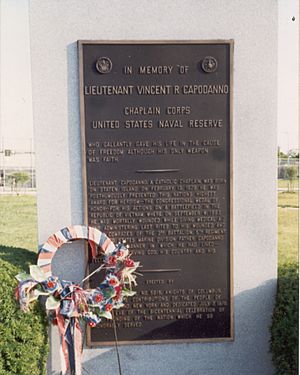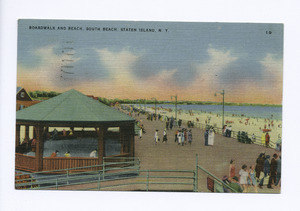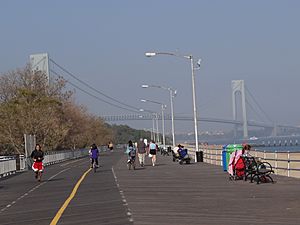South Beach–Franklin Delano Roosevelt Boardwalk facts for kids
Quick facts for kids South Beach–Franklin Delano Roosevelt Boardwalk |
|
|---|---|

The northern end of the boardwalk at Fort Wadsworth
|
|
| Location | Staten Island, New York |
| Nearest city | New York City |
| Area | 2.5 miles (4.0 km) long by 40 feet (12 m) wide |
| Created | 1937 |
| Operated by | New York City Department of Parks and Recreation |
| Visitors | 334,000 (2017) |
| Open | 6 a.m. to 1 a.m. |
| Status | open |
The South Beach–Franklin Delano Roosevelt Boardwalk is a long wooden walkway on Staten Island, one of New York City's five boroughs. People often call it the FDR Boardwalk or the South Beach Boardwalk. It faces the Lower New York Bay on the East Shore of Staten Island.
This boardwalk is the main part of a large public park. The park stretches from Fort Wadsworth and the Verrazzano-Narrows Bridge all the way to Miller Field. Both of these areas are part of the Gateway National Recreation Area. The park also has many fun places to play, including a skate park.
Years ago, the Staten Island shore had many amusement parks. These parks closed down by the 1930s. Workers started building the boardwalk in 1935, and it was finished by 1937. Some amusement rides stayed on the boardwalk until the late 1950s. After that, water pollution and other changes made fewer people want to visit.
The boardwalk was fixed up in a big project in the late 1990s. Even with the improvements, it is still not as busy as other places. In 2017, about 334,000 people visited South Beach and the Boardwalk. This is much less than the millions who visit Coney Island.
Contents
Exploring the FDR Boardwalk
The South Beach–Franklin Delano Roosevelt Boardwalk is about 2.5 miles long. It runs from Fort Wadsworth in the north to Miller Field in the south. In 2010, a book called The Encyclopedia of New York City said it was the fourth-longest boardwalk in the world.
As you walk from north to south, you pass through different neighborhoods. These include Arrochar, South Beach, and Midland Beach. When it was first built, the boardwalk was 40 feet wide. This was half the width of the 80-foot-wide Riegelmann Boardwalk at Coney Island. Coney Island is across the bay in Brooklyn.
The FDR Boardwalk is made of concrete and wood. It has several buildings along its path. These include pavilions, restrooms, and "comfort stations." A wide road, now called Father Capodanno Boulevard, was built next to the boardwalk. There is also a special bike lane that runs the whole length of the boardwalk. It is separate from other traffic, making it safer for cyclists.
The South Beach–Franklin Delano Roosevelt Boardwalk is not as busy as other beaches in New York City. For example, in 2017, it had 334,000 visitors. Orchard Beach in the Bronx had 2 million visitors. Rockaway Beach in Queens had 5 million, and Coney Island had 6.7 million visitors.
Fun Things to Do at the Boardwalk
The South Beach–Franklin Delano Roosevelt Boardwalk has two main beach areas. South Beach is to the north of Sea View Avenue, and Midland Beach is to the south. These beaches offer many sports and activities. You can play baseball, handball, shuffleboard, bocce, checkers, volleyball, and roller hockey. There is also the Ben Soto Skate Park and the Ocean Breeze Fishing Pier.
The boardwalk has eight baseball fields. Five are near Midland Beach, and three are near South Beach. Two of the baseball fields in Midland Beach are also used for rugby. There is a basketball court near the south end of the boardwalk, at Greeley Avenue. The Detective Russel Timoshenko Soccer Field is further north. It is named after a police officer who died in 2007.
At the northern end, you can find three bocce courts near Drury Avenue. There are also two volleyball courts near Doty Avenue. Three playgrounds for children are located along the boardwalk. These are Playland at Sand Lane, Midland Playground at Graham Avenue, and Midland Beach Playground at Greeley Avenue.
Statues and Important Monuments
The Fountain of the Dolphins is a beautiful statue at South Beach. It was made by sculptor Steven Dickey. The statue was given to the park in 1998. It shows six bronze dolphins with colorful water jets.
The Capodanno Memorial honors Father Vincent R. Capodanno. He was a local resident and a chaplain in the United States Navy. He died in 1967 during the Vietnam War. A granite monument was put on the boardwalk for him in 1976. The road next to it was renamed Father Capodanno Boulevard that same year. The memorial is at Sand Lane and Fr. Capodanno Boulevard. It has a bronze and steel tablet set into a granite stone.
The Midland Beach War Memorial is near Fr. Capodanno Boulevard and Midland Avenue. It is a three-part stone slab made of Barre granite. An eagle figure is carved on top of the base.
Ben Soto Skate Park
The Ben Soto Skate Park is a place for skateboarding and BMX biking. It is located at the Midland Beach Playground. The skate park is made of concrete and metal. It opened in 2005 and is named after a local Marine who died four years before.
By 2010, the skate park needed repairs. Michael Grimm, who would soon become a U.S. Representative, promised to fix it. The park was renovated in 2011. However, some local skateboarders and bikers have said it needs more traditional skatepark features like ramps.
History of the Boardwalk
Early Days and Amusement Parks
The East Shore of Staten Island was first settled by the Dutch. They created the neighborhoods we now know as Midland Beach and South Beach. People started building summer homes along the beach in the mid-1700s. But these areas stayed mostly rural until later in that century.
By 1882, business people saw that the area could become a resort. They added fun places like theaters, hotels, bathing areas, and casinos along the shore. Two amusement parks, Happyland Amusement Park and Midland Beach, were built where the boardwalk is today. In 1884, the South Beach Branch of the Staten Island Railway opened. This made it easy to get to the Staten Island Ferry at St. George Terminal.
Because it was easy to reach from Brooklyn and Manhattan, these resorts became popular amusement spots. They were similar to Coney Island. Today, the South Beach–Franklin Delano Roosevelt Boardwalk stands where these old amusement areas once were.
By the mid-1880s, South Beach had a 1,700-foot-long boardwalk. It also had a beach and many rides. A fire in September 1896 destroyed much of the area. But on June 30, 1906, the 15-acre Happyland Amusement Park opened. It was a closed park with many rides and beautiful landscapes. The park had a 1,000-foot beachfront, a 1,500-foot pier, and a 30-foot-wide boardwalk. It also had over 10,000 lights and many roller coasters.
Midland Beach, located southwest of South Beach, became a resort by the 1890s. It had a 1,700-foot pier that went into the Atlantic Ocean. Visitors could take a steamboat from there to the Battery in Lower Manhattan. The pier was so long that a miniature railroad took people to the end. Like South Beach, Midland Beach offered theater shows, a beach, picnic areas, snack stands, hotels, and amusement rides. It also had its own boardwalk.
During World War I, air and water pollution, along with fears of German attacks, made fewer tourists visit Staten Island. However, visits increased after the war. By 1923, Staten Island had record numbers of visitors. One day in June 1923, 150,000 people visited.
The amusement parks were mostly destroyed by fires in the 1920s. A 1919 fire in South Beach ruined much of its amusement area. Midland Beach was hit by two fires in 1924. The first made it hard for boats to reach Midland Beach. The second destroyed part of its amusement area. Both areas were rebuilt, but then both burned down again in 1929.
One small part of the amusement area, the 1-acre South Beach Amusement Park, kept operating until the late 1900s. But much of that park was destroyed in 1955. Beachland Amusements, a nearby arcade, was open from 1941 to 2006. It was the last amusement attraction on the South Beach–Franklin Delano Roosevelt Boardwalk.
Building the Boardwalk
In 1930, a law was passed to set aside $1 million for a new beach and boardwalk on Staten Island. It would run between Fort Wadsworth and Miller Field. In 1934, New York City decided that the 2.5-mile shorefront would become public land.
Then, Staten Island's borough president, Joseph A. Palma, suggested building a boardwalk to connect South Beach and New Dorp. This 2.5-mile boardwalk would cost $2 million. It would be built by the Works Progress Administration (WPA), a government program that created jobs. Part of the money would come from another program, the Public Works Administration. People hoped the project would make property values go up, just like other boardwalks in New York City had done.
On August 11, 1935, officials held three groundbreaking ceremonies. More than 10,000 people watched as construction began. The actual work on the boardwalk started a month later. Palma thought the project would create jobs for up to 4,000 people.
New York City Department of Parks and Recreation (NYC Parks) commissioner Robert Moses was not a fan of the boardwalk. He said it would encourage private companies to block access to the beach. The project was described as a mix of Coney Island's Riegelmann Boardwalk and Jones Beach.
The plans called for a 180-foot-wide beach to be built before the boardwalk. But construction did not follow this order exactly. This meant some parts of the boardwalk site were flooded at high tide. Because of this, WPA workers sometimes worked only 6 hours a day, or even less than 4 hours.
Despite these issues, the boardwalk was built quite fast. The first 1-mile section, between Fort Wadsworth and South Beach, was almost done by the end of 1936. Twelve jetties (structures that protect the shore) and a parallel beach section were also finished. By June 1937, the entire boardwalk was mostly complete.
An official opening ceremony was held on July 4, 1937. About 25,000 people attended. The boardwalk was named after U.S. president Franklin D. Roosevelt, who took part in the ceremony from afar.
Early Years and Changes
In September 1937, three hundred bathhouses on the new boardwalk burned down. In 1940, the United States Army announced plans for a pier at Lily Pond Avenue. This pier, at the northern end of the FDR Boardwalk, would help their activities on nearby Hoffman Island and Swinburne Island.
Also, a rule from NYC Parks at first stopped wounded war veterans from using the South Beach–Franklin Delano Roosevelt Boardwalk. This was because wheelchairs were not allowed on the boardwalk. So, in 1945, Palma made an agreement. These veterans could use Midland Beach instead, which was privately owned at the time.
In 1953, Staten Island borough president Edward G. Baker and NYC Parks commissioner Moses suggested a big plan to fix up the boardwalk. They said improving the boardwalk would make the whole East Shore of Staten Island better. This was similar to how the Rockaway Boardwalk had improved the Rockaways. At that time, 1.2 million people visited the beach and boardwalk each year.
The $6.46 million project to improve Staten Island's East Shore beaches started the next March. Moses also suggested charging 25 cents for parking and 10 cents to enter the boardwalk. He thought this would attract up to 2.4 million people within 30 years.
The project included adding bathhouses and parking lots for 7,000 cars. It also added bus stops, comfort stations, and many sports facilities. These included playgrounds, baseball fields, handball courts, roller hockey fields, skateparks, shuffleboard courts, bocce courts, and checkers tables. About 2 million cubic yards of sand were taken from the Lower New York Bay to protect the land next to the boardwalk.
Moses said that in the original project, the land next to the boardwalk was too small for recreational facilities. But now, the city had enough land to build them. The project also included building Seaside Boulevard (now Fr. Capodanno Boulevard) next to the boardwalk. The first part of this road opened in 1957.
The first part of the renovation was finished in 1958. When the project was fully completed in the 1960s, it included three sections. These were the original South Beach, plus two new sections at Graham and Midland Beaches. This renovation happened at the same time as the planning for the Verrazzano-Narrows Bridge. This bridge would be Staten Island's first physical connection to the rest of New York City. In 1967, almost $1 million was set aside for more improvements to the boardwalk. More money was given in 1977.
Decline and Comeback
The boardwalk started to get less popular in the 1950s. This was because of problems like water pollution. Sewage from Manhattan and New Jersey flowed into the bay, making the water dirty. By the 1960s, even some lifeguards did not want to swim in the water near the boardwalk. Another problem was that the Staten Island Railway stopped service to South Beach in the mid-1950s. This made the boardwalk hard to reach for most people.
The beaches along the boardwalk stayed polluted. In 1983, New York City Comptroller Harrison J. Goldin said the boardwalk was in "poor" condition. This was because of the dirty water and poorly kept boardwalks. At that time, only 1,200 people visited the beach on a busy day. In 1985, a small part of the boardwalk was named a "quiet zone." This meant loud radio playing was not allowed there.
In the mid-1980s, the NYC Parks budget grew a lot. This allowed them to fix two baseball fields at the boardwalk in 1986. They also put in new benches. But the water pollution near the boardwalk got so bad that the city stopped putting lifeguards there in 1990. The beach and boardwalk continued to suffer from damage, pollution, and general neglect.
A New Beginning
The beachfront got a major makeover in the 1990s. In May 1994, a fire accidentally destroyed 200 feet of the boardwalk. After this, the borough president, Guy Molinari, announced a $650,000 renovation for the damaged section. Several million dollars were set aside for other related projects.
These projects included turning parking lots into South Beach Park, which opened in June 1996. They also rebuilt the fire-damaged part of the boardwalk and renovated a playground. NYC Parks also looked for businesses to run a pavilion at Sand Lane, which had also been damaged in a fire. New recreation facilities for older adults and a series of concerts were added.
The renovation of the boardwalk also included cleaning up the waterfront. Full funding for lifeguards was provided, and they started working at South Beach again in July 1997. The rebuilt boardwalk officially opened in October 1997.
More improvements were made under the leaders Guy Molinari and his successor, James Molinaro. These included adding the Dolphin Fountain at the north end of the boardwalk. A monument for veterans called Freedom Circle was added at the south end. New parking lots, a $1.8 million pavilion, and new lighting were also installed.
The Ocean Breeze Fishing Pier opened in September 2003. This pier is made of steel and concrete. At 835 feet long, it is the largest oceanfront recreational pier built in the New York metropolitan area in over a century. One estimate said that about $20 million had been spent to improve the South Beach–Franklin Delano Roosevelt Boardwalk since 1995.
The beaches still had problems with pollution. A New York City Council report in 2004 said South Beach and Boardwalk were the dirtiest of the city's seven beaches. A separate survey in 2007 said South Beach was "challenged," but Midland Beach was in much better condition. In a 2009 survey, South Beach's boardwalk, facilities, and beach were rated as poorly maintained. But by 2011, it was rated as the best-maintained beach in the city, even better than Midland Beach.
Wi-Fi service from AT&T became available along the boardwalk in 2012. This made it one of several Wi-Fi hotspots in the city. In October of that year, Hurricane Sandy damaged the South Beach–Franklin Delano Roosevelt Boardwalk. Over nine months, parts of the boardwalk were slowly repaired and reopened. Workers from other boroughs helped fix the boardwalk quickly. One damaged part, a ramp that was accessible for people with disabilities, was not repaired until 2018.







